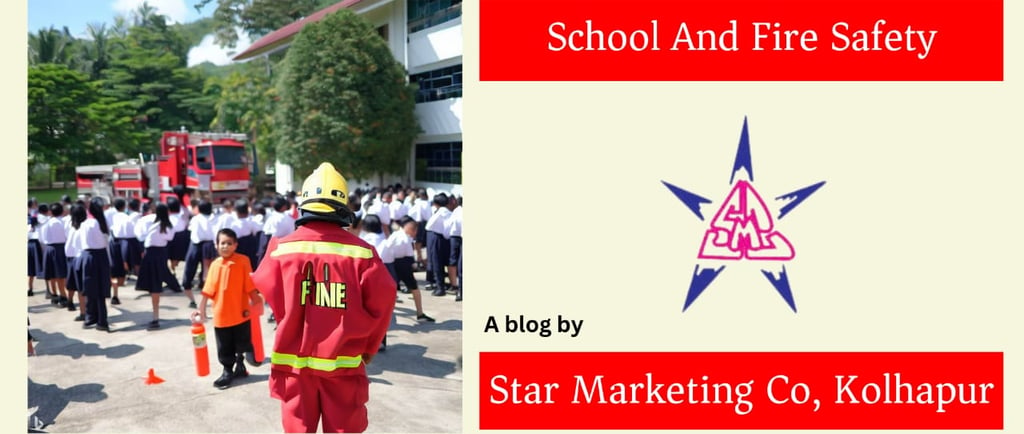School And Fire Safety
Importance of Fire Equipment, Installations, and Safety Lessons for school children


Introduction
Fire safety in schools is of paramount importance to protect the lives of students, staff, and valuable educational resources. Implementing effective fire safety measures, including the installation of appropriate fire equipment, conducting safety lessons, and obtaining necessary permits, is crucial to creating a secure learning environment. This article aims to highlight the significance of fire safety in schools and explore key aspects such as fire equipment for schools, fire fighting system installations, safety lessons for school children, obtaining NOC from the fire department, the role of sprinklers, and the importance of fire alarm detection systems. By prioritizing fire safety, schools can ensure the well-being of their occupants and mitigate the devastating consequences of fire incidents.
1. Fire Equipment for Schools
Equipping schools with appropriate fire equipment is a fundamental step towards enhancing fire safety. Fire extinguishers, fire blankets, and fire hose reels should be strategically placed throughout the school premises, ensuring easy access in case of an emergency. Fire extinguishers should be regularly inspected, maintained, and replaced as needed to ensure their effectiveness. Additionally, fire equipment should be properly labeled and accompanied by clear instructions on their usage. Regular training sessions should be conducted for staff members to familiarize them with fire equipment and their operation.
2. Fire Fighting System Installations for Schools
Installing an efficient fire-fighting system is vital for schools to effectively combat fire incidents. A comprehensive fire fighting system includes elements such as fire alarms, smoke detectors, sprinkler systems, and fire suppression systems. Fire alarms and smoke detectors should be strategically placed throughout the school to provide early warning in the event of a fire. Sprinkler systems play a critical role in suppressing fires, preventing their spread, and buying crucial time for evacuation. Fire suppression systems, such as foam or gas-based systems, can quickly extinguish fires and minimize damage. It is essential to work with qualified fire safety professionals to design and install these systems according to the specific requirements of the school.
3. Fire Safety Lessons for School Children
Educating school children about fire safety is a proactive approach to reducing the risk of fire incidents. Fire safety lessons should be incorporated into the curriculum, teaching students about fire hazards, prevention techniques, and appropriate responses in case of a fire. Topics to cover may include identifying fire exits, practicing evacuation drills, understanding the importance of not tampering with fire equipment, and teaching basic fire extinguisher usage. By instilling fire safety knowledge at an early age, children develop a responsible and safety-conscious mindset that will benefit them throughout their lives.
4. Obtaining NOC from the Fire Department
To ensure compliance with fire safety regulations, schools must obtain a No Objection Certificate (NOC) from the local fire department. The NOC signifies that the school premises meet the necessary fire safety standards and guidelines. Schools should collaborate with fire safety experts to conduct thorough inspections, address any identified shortcomings, and make the required modifications. This process includes evaluating fire exits, electrical installations, fire equipment adequacy, and overall compliance with fire safety codes. By obtaining the NOC, schools demonstrate their commitment to the safety of their students and staff.
5. Role of Sprinklers in Schools
Sprinkler systems play a crucial role in schools' fire safety, as they can swiftly suppress fires and limit their spread. In the event of a fire, sprinklers activate automatically when the temperature rises, effectively dousing the flames and reducing heat and smoke. The presence of sprinklers not only helps control the fire but also provides additional time for evacuation and emergency response. Schools should ensure that sprinkler systems are regularly inspected, maintained, and tested to guarantee their optimal functioning.
Conclusion:
A school is a place where children study and spend most of their time of the day without the safety net of their parents. School management will always remain responsible for the safety of the children. Having a system to prevent and extinguish the fire is never enough to protect small children. School management should proactively start educating children about fire safety. They can always ask for the help of a fire-fighting agency to arrange training for their staff and children. Fire-fighting agency can always arrange for mock drills too that will help school management, its staff and children to evacuate if at all unfortunate incidents like fire arises.
